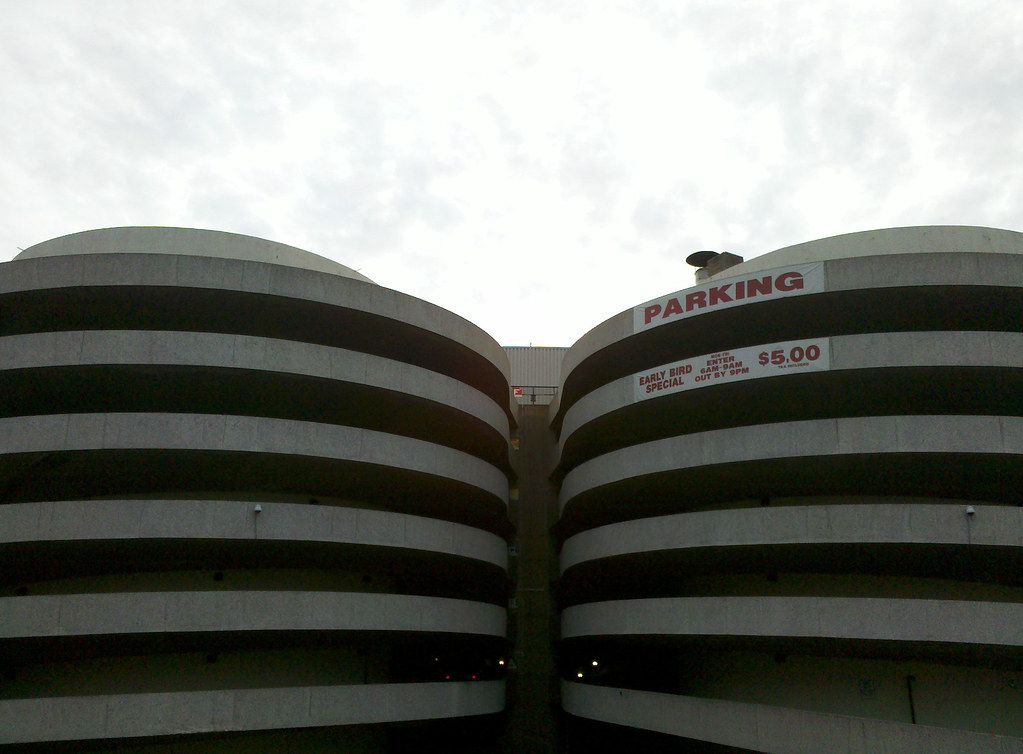
As I was taking this photo of the parking ramps at the Queens Place mall, an employee saw me and started walking toward me. Generally this means I'm about to get asked, with a fair amount of suspicion, "Hey, what are you doing?" I find this attitude rather disheartening; is it so hard to believe someone might be taking a genuine interest in your home or workplace, rather than trying to screw you over in some way?
Needless to say, I was pleasantly surprised when this gentleman turned out to have approached me for a different reason altogether: to give me a tip on how to better appreciate this obviously (to him, anyway) noteworthy structure: "Pretty cool, huh? You should go online and check out the aerial photo. All these circles — it looks awesome." This revealed a curiosity, an engagement with the world, and a desire to share that were all really encouraging to me. For some reason, the phrase "ray of hope" popped into my head, symbolizing this one success in the fight against being too cool or important or busy to care about things like neat-looking parking ramps. So you can imagine my shock when I caught a glimpse of his ID badge and saw the name printed on it: Raymond Hope.
The previous sentence is not true.
So, without further ado, here is the aerial photo. Ol' not-Ray was right: there's certainly some unusual geometry at work here. But the circles are only part of the story.
This mall was originally an enormous Macy's department store that opened in 1965. Two years earlier, Macy's began buying up all the land on the irregularly shaped five-acre block where the mall now sits. Everyone sold out except for one little old lady, a widow by the name of Mary Sendek (or Sondek, depending on your source), who lived at the corner of Queens Boulevard and 55th Avenue. The proposed layout of the arena-like store called for only a slight intrusion into her backyard, but rather than shrink the circle by a few feet, Macy's decided to start building the original design, assuming she was just holding out for more money and could be bought off before the construction reached her property.
Macy's offered as much as $200,000, but Ms. Sendek refused to budge. She apparently had a dog she was very fond of, and didn't want to deprive him of the spacious backyard he so enjoyed. So Macy's had to cut a little notch (clearly visible from above) out of their otherwise perfect circle to skirt the edge of her backyard. Here's a great photo of her house standing alone against the immense, indented facade of the store.
Ms. Sendek died some years later, and a strip mall was built on her former property. As you can see, it takes up the full extent of the lot, all the way into the notch in the wall. Her legacy lives on.
I'm walking every street in New York City.
This is the counterpoint to my walk across the US. Instead of seeing a million places for just a minute each, I'm going to spend a million minutes exploring just one place. By the time I finish walking every block of every street in all five boroughs, I'll have traveled more than 8,000 miles on foot — all within a single city. Details!
Email me at matt@imjustwalkin.com
Subscribe to my email list
Maps: Progress | Photos
Your donations allow me to keep walking full-time. If you think what I'm doing is valuable and you'd like to offer some support, I would be very grateful. On the other hand, if you think I'm a worthless bum, feel free to email me and tell me to get a job, bozo. Both are excellent options!



yeah that parking lot is quite bizarre-I remember that old house very well- didnt know it was finally knocked down
I used to live 2 blocks from this mall. It now houses Target on its top two floors, quite a fitting place for the store. Imagine doing business in a building shaped like your logo, isn’t it cool? The small circular building near the strip mall is now a bank. I’ve been to this building so many times but never realized there’s that small notch .. thanks for that little bit of trivia.
Great story. I don’t think I’ve laughed out loud in a long time – but tonight I did – after your admission of untrue sentence in second paragraph. :)
I can’t get over that street you have there that I see in the aerial shots, looks like 4 separate sections running parallel to one another. What kind of a street is that? How on earth do you drive it? Is it a freeway of some kind in the middle and then access road along the sides? Looks crazy wild to me.
That’s Queens Blvd., which is considered as one of the most dangerous thoroughfares in New York City, and has sometimes been referred to as the Boulevard of Death because a lot of pedestrians were killed crossing it. The four sections you see are actually 12 lanes, cut into three-lane sections by small medians so the people crossing could stop in between and prevent more accidents .. http://en.wikipedia.org/wiki/Queens_Boulevard
Great story Matt. A true victory for the little guy. Just goes to show that throwing money at a problem does not always solve it.